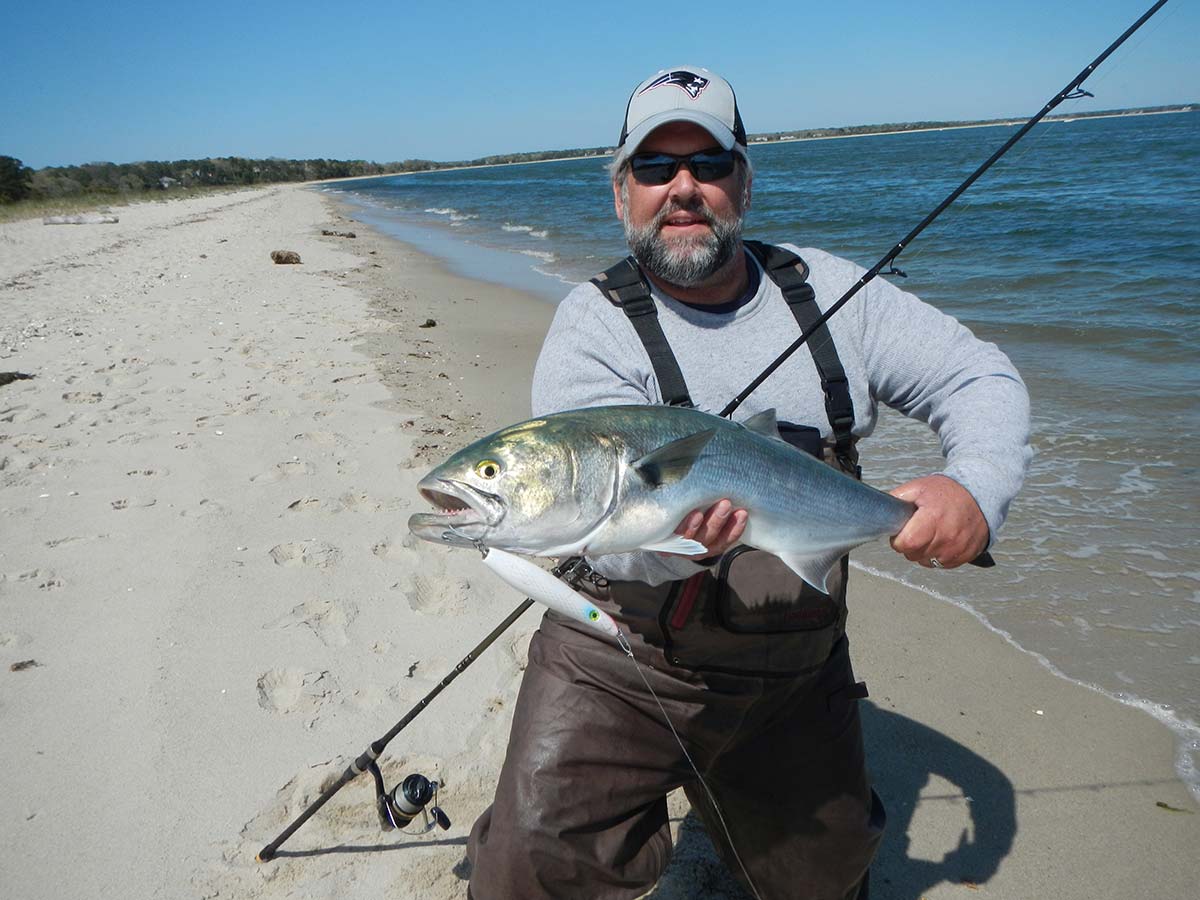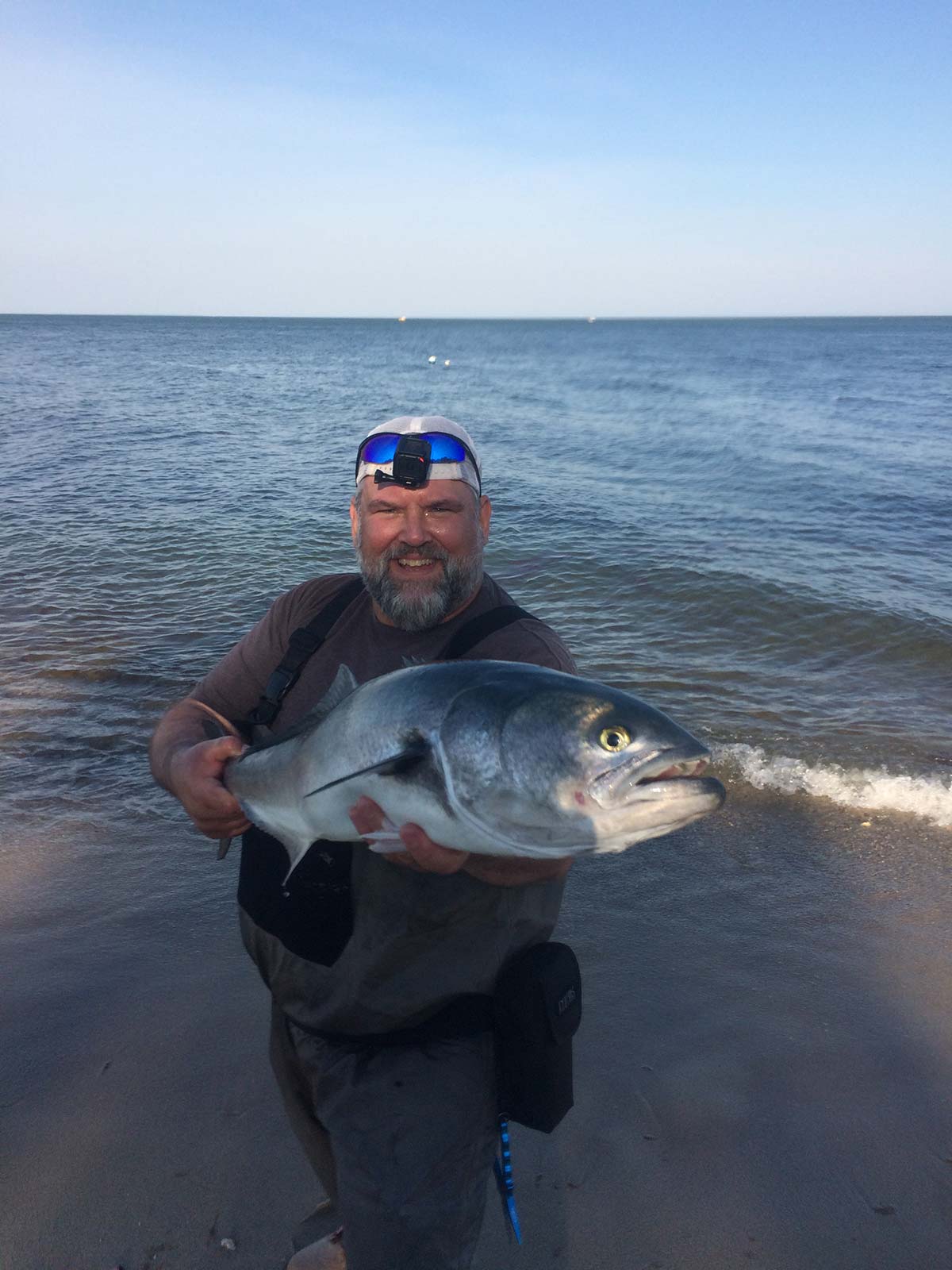
An anecdotal look at recent trends in the spring bluefish fishery of Southern New England.
Springtime on Cape Cod, as it has for some 30-plus years, means one thing for me: bluefish on the beach! Hungry hordes of choppers chase an assortment of bait including herring, squid, pogies, and any other prey unlucky enough to be in their path as they invade the warming waters of south side Cape Cod. These home-waters of mine seem to always produce a consistency of yellow-eyed devils for which I had become accustomed to, with fish from 3 to 10-plus pounds landed consistently enough to expect their presence; but recent years had brought Godzilla to the waters.
Back in 2017, just a short, three years prior to the COVID-19 world, things started off with a sandy trek along these same beaches. John Rice and I scanned the rippling waves for greasy slicks, telltale signs of bluefish feeding; the brisk SW making it difficult to locate. Nevertheless, we let fly with our chewed-up pencil poppers, scarred from previous years’ encounters, and a few cranks of the reel immediately confirmed what we had already expected. A big blue slashed and missed the plug again and again until I came tight to a teen-sized bruiser. I glanced over to John to shout “I’m on,” but he was already in mid-battle of his own. We released a pair of 15-pound-class fish and smiled, knowing we were in it. We were only a couple of hours into the flood tide, a peak time in this location, and the morning had already revealed its prize.
Casting casually as we made our way down the beach, past the broken jetties and sandy stretches, we eventually arrived at a long flat where the current rolled over a rip stretching from an aforementioned jetty. Here is where the real fun started, producing one of the most memorable surfcasting days in recent years. Wading out over the thigh-deep water, we witnessed schools of adult pogies swimming in nervous patches over the flat. Herring and squid could be seen, too, all gliding over the stretch of sand with large, looming shadows following. We moved as slowly as possible through what would soon become a boiling cauldron of shimmering scales. The fishing that unfolded for the next few hours through the turn of the tide was nothing less than spectacular, with the smallest specimen being in the low teens and the largest pushing if not touching the elusive 20-pound mark. We didn’t need a scale to tell us, although at one point we just had to check with a fish ticking just at 18. Indeed, action was so absurd that at one point I had a pack of three monster blues casually swim a few feet in front of me, and all I did was open my bail. When the Guppy pencil hit the water, it was immediately engulfed just inches from my rod tip by a bloated blue torpedo!
The next few weeks saw the action continue, although not as epic as that memorable outing. Most days saw large fish until the usual summer pattern rolled in and the better schools moved offshore. So, it was of no concern the following spring of 2018 to expect anything but the same. Perhaps not the few days of Armageddon like we experienced the previous May, but topwater bluefish action we’d come to expect; perhaps even to take for granted. But memory has a way of skipping over the bad parts, and it would soon come back to remind us of the lean years peppered over the decades and stored in the back of our brains. Those buckets where the slow years went, or the “no” years went, the bottom of the barrel that we deemed the down cycle.
That first outing of 2018 we repeated our typical steps, cast after cast, making our way through our usual spots, but gone were the bluefish. In their place were schoolie bass, and some days decent action, but for the most part a fraction of what we were missing. Then 2019 came and went with a lean handful of blues in the fall, mostly bycatch while hunting pelagics inshore. In 2020? Well, more or less a repeat of the previous two years, with the added black cloud of COVID-19. There were signs later in the season of some promise as bigger bluefish showed offshore, as well as a few 3- to 5-pounders during my jaunts for other species, but was this just a tease? Was this part of the cycle? Were these cycles predictable?

Early in my surfcasting adventures, old-timers would speak of the cycles of bluefish. Up, down, long stretches of good years interspersed with buckets of down years. “Every ten years” some would say. Others, “every 15”, and so on. But… what is the real deal with these cycles? I reached out to try and find an answer, other than my own educated evaluation.
According to multiple sources, including scientists from the Massachusetts Division of Marine Fisheries (DMF) and the Atlantic States Marine Fisheries Commission (ASMFC), the general consensus is that there is no specific window that can be identified; or, in other words, trying to plan for a cycle every 10 years simply cannot be validated. However, there is a vast amount of stock assessments and data based on what we could call cycles, where the trends, the “ups” and “downs”, can reflect historically of what could be impacting the stocks.
Essentially, this confirms what my suspicions have led me to over the years. There are numerous, environmental influences, as it were, which can dictate trends affecting the fisheries including competition among species, the availability of plentiful bait sources, weather patterns, and overfishing. Unfortunately, this was just such blueprint as we had spread out before us in the past few years as we hit this current low with bluefish.
Striped bass, the holy grail for most New England surfcasters, had made an impressive comeback from the lowly days of the 80s with big schools of fish followed by even bigger fish (until the most recent years), which undoubtedly saw an increase in competition for bait resources. Compare this to the 1980s when bass were much more scarce. During this time, it wasn’t unheard of to have banner days, every day, in spring when marauding schools of big blues would feast unmolested. This continued for some time into the 90s, when bloated bluefish, binging on squid, began to mix-in with the rebounding bass. The lessening schools of bluefish didn’t seem apparent at first because of the surging striper fishery.
Meanwhile, Nantucket Sound had been getting cleaned out of their usual springtime squid run, and the likelihood of walking the beach and dodging regurgitated squid chunks wasn’t as common as it once was. Sure there were years in-between with outlandish catches, where everyone would laugh at the return of the golden days, but quantity was put to the side, replaced with quality. For me and my salty sidekicks, this culminated in the mid-2010s, those epic couple of weeks with monsters on the flats followed by what can only be described as a crash.
Fear not, for this current round of a downturn has not gone unnoticed by those who attempt to regulate. Finally, after years of an absurdly-high catch limit of 15 fish per angler, 2020 saw a change implemented to lower the limit to three fish per angler, and five for recreational for-hire anglers. It’s a step in the right direction, to be sure; but don’t expect an immediate turnaround as we still need to keep the light shining on bait stocks, and the impact of offshore targeting of the species that serve as prey, to include focusing on sustainability. Additionally, while die-hard striped bass fishermen don’t want to hear this, the numbers of bass have been in decline for a couple of years, and this should ease the competition for prey amongst the bluefish.
Will this be the year we can put on record as the first of the rebound years of the 2020s? There’s only one way I know of to find out for sure. Topwater plugs? Check. Kastmasters? Check. Waders? Check. I’ll see you in the suds!



